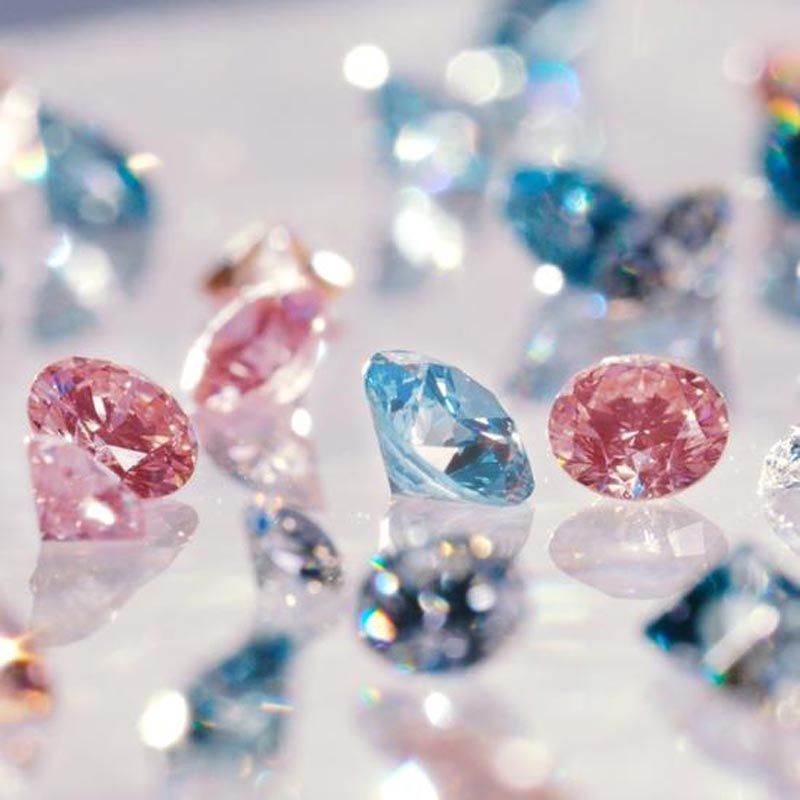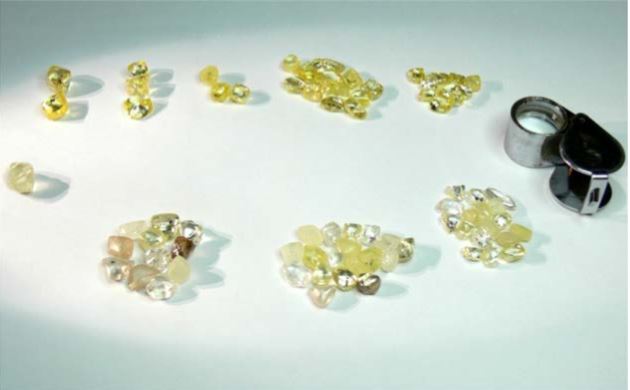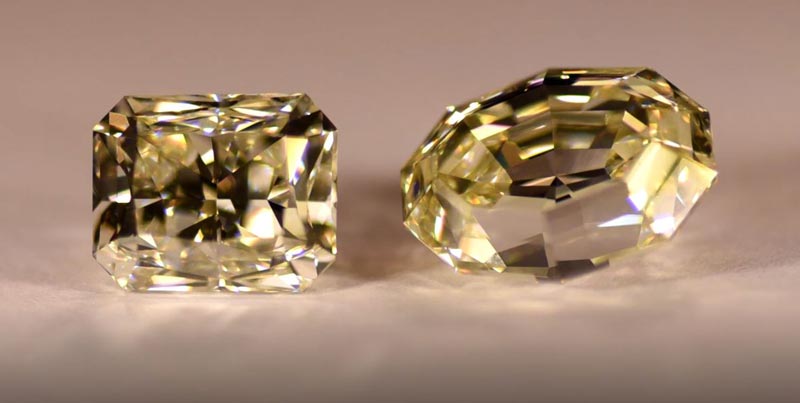You might be interested in
Mining
Rio Results: Rio falls short of expectations on iron ore and copper in March quarter, but says 2024 is on track
Mining
Bulk Buys: Wet weather keeps iron ore exports in check and From Russia with a Shove
Mining
Mining
They say “diamonds are a girl’s best friend” (well, for some girls anyway), and lab-grown diamonds now appear to be coming into favour – so will they prefer a substitute or do they want the real deal?
The declining production of the precious gem has seen large producers take a punt on lab-grown diamonds to meet demand.
>> Scroll down for a list of ASX stocks with diamond projects, courtesy of leading ASX data provider MakCorp
Lab-grown diamonds have the same physical, chemical and optical characteristics as rare, natural diamonds, but they are not as valuable or precious.
Though diamond giant De Beers, which launched its own lab-grown fashion jewellery retailer called “Lightbox Jewelry” last year, says they are “just as sparkly”.
Want to know how it’s done?
Basically a tiny piece of lab-grown diamond (kind of like a seed) is placed into a plasma reactor and heated to over 3300 degrees Celsius.
After about 400 hours it can be cut into a polished stone, but if you want it bigger it needs to stay in longer.
Lightbox Jewelry can even make its diamonds “plush pink” or “powder blue”.

A quarter carat is worth $US200 ($277), while a 1 carat costs $US800, according to the company’s pricing.
But Lightbox Jewelry does not provide grading reports for its products because it doesn’t want to confuse customers about the value of their lab-grown stones.
Like any market, substitution will have an impact on rough diamond sales, but Bain & Company and the Antwerp World Diamond Centre say that impact can be limited if the natural diamond industry sets itself apart.
“The effects on natural diamond demand and price will depend on consumers’ perceptions and preferences,” says Olya Linde, partner at Bain & Company and lead author of the eighth annual report on the global diamond industry.
“If the natural diamond industry can differentiate its stones from lab-grown diamonds (perhaps positioning lab-grown diamonds as fashion jewellery rather than luxury items), the effect on natural diamond demand by 2030 will be limited up to 5 per cent to 10 per cent in value terms.”
According to independent diamond analyst Paul Zimnisky, production of lab-grown diamonds surpassed 1.5 million carats annually last year and is still rising.
“I see the lab-grown diamond jewellery market growing from $US2 billion today to $US15 billion by 2035, with market share encroaching more on the fashion jewellery market than the fine jewellery market,” Mr Zimnisky told Stockhead.
In the short to medium term, lab-grown diamonds are expected to be limited by manufacturing capacity, access to technology and intellectual property, and availability of funding.
There is a potential upside to the increased availability of lab-grown diamonds though – it may just help demand for natural diamonds, according to Ms Linde.
“Given the pace of declining production costs and wholesale and retail prices, we expect lab-grown stones to become accessible to a wider consumer audience, potentially increasing demand for diamonds in general,” she said.
Kieron Hodgson, executive director – commodities and mining research for London-based stockbroker Panmure Gordon, says lab-grown diamonds currently only represent about 1 to 2 per cent of global diamond production — or up to 20 per cent of the total production being lost by Rio Tinto’s (ASX:RIO) Argyle mine closing.
“Lab-grown diamonds have a place for consumers, however their pricing will differ significantly from natural diamonds thus the two can co-exist, in the same way as current lab-grown gemstones do,” he told Stockhead.
Mr Zimnisky sees global consumer diamond demand growing a nominal 3.5 per cent in 2019, a moderate decline from 2018 estimates of 4 per cent.
He says the year-over-year decrease is due to expectations that corporate earnings growth in the US — the diamond industry’s largest consumer market — will abate and trade tensions as well as other geopolitical uncertainties will weigh on economic growth.
Less diamonds being dug up
But at the same time the global production of natural diamonds is forecast to drop by 2.8 per cent to 145 million carats in 2019.
Mr Zimnisky says this is primarily driven by an expected production cut at De Beers as its Victor and Voorspoed mines reach end of life and as Venetia, the company’s largest mine in South Africa, realises open-pit production declines.
The Luaxe project in Angola is the only new diamond mine in development globally and is expected to produce more than 1 million carats each year.
Mr Zimnisky says it has the potential to be a top-five largest-producing diamond mine in the world, but first commercial production is not expected before 2022.
In terms of prospective places to look for diamonds, Australia is at the top of Mr Zimnisky’s list.
“I see Australia as one of the most prospective jurisdictions for diamond exploration,” he said.
“I also see Canada, Angola, Botswana and Brazil as other prospective jurisdictions for greenfield diamond exploration.
“While the DRC and Zimbabwe are highly geologically prospective, geopolitics have greatly hindered exploration and development, Russia remains quite prospective as well but is essentially closed to outsiders.”
There are just 11 ASX small cap explorers that have diamond projects. Eight of those have projects in Australia.
Here’s a list of ASX stocks with diamond projects courtesy of leading ASX data provider MakCorp
Scroll or swipe for full table
| Code | Name | Project Location | Price Jan 11 (intraday) | 1-year change | Market Cap |
|---|---|---|---|---|---|
| ARV | ARTEMIS RESOURCES | Western Australia (Pilbara region) | 0.125 | -0.490196 | $84.3m |
| ARO | ASTRO RESOURCES | Western Australia (East Kimberley region) | 0.003 | 0% | $3.8m |
| AUT | AUTECO MINERALS | South Australia | 0.005 | -0.166667 | $4.5m |
| FDX | FRONTIER DIAMONDS | South Africa | 0.024 | -0.85 | $5.6m |
| GIB | GIBB RIVER DIAMONDS | Western Australia (West Kimberley region) | 0.057 | 0.117647 | $10.2m |
| JRL | JINDALEE RESOURCES | Western Australia | 0.28 | 0.098039 | $9.8m |
| LOM | LUCAPA DIAMOND CO | Lesotho, Angola & Botswana | 0.195 | -0.071429 | $92.1m |
| MED | MERLIN DIAMONDS* | Northern Territory (McArthur River Basin) & Western Australia | 0.006 | 0% | $21.8m |
| MEI | METEORIC RESOURCES | Western Australia | 0.01 | -0.784314 | $5.7m |
| NWF | NEWFIELD RESOURCES | Sierra Leone | 0.18 | -0.216203 | $113.4m |
| DEV | DEVEX RESOURCES | Western Australia | 0.046 | -0.6695 | $4.51m |
*MED has been suspended since September 28.
Western Australia’s Kimberley region is well-known for its diamonds and is often called Australia’s diamond exploration “hot-spot”.
Perth-based DevEx Resources (ASX:DEV) applied for eight exploration licences in the region mid-last year.
The licences span 2700 sq km between Rio Tinto’s Argyle mine and the former Ellendale mine once owned by Kimberley Diamonds.
Rio’s Argyle mine is one of the world’s largest suppliers of diamonds — and the world’s largest supplier of natural coloured diamonds.
Until its closure in 2015, Ellendale produced more than 50 per cent of the world’s fancy yellow diamonds.
At one stage Argyle and Ellendale together accounted for a third of global annual production.
DevEx’s landholding also lies to the south of Lucapa Diamond’s (ASX:LOM) Little Spring Creek prospect.
Lucapa also has two operating mines in Africa — Lulo in Angola and Mothae in Lesotho.
In early December, the company showed off the largest “special” recovered so far from the 1.1-million-tonne-per-annum (Mtpa) plant at Mothae.

Head of investor relations Mark Drummond told Stockhead at the time the large special will be included in the first sale of commercial diamonds, which is scheduled for the first quarter of this year.
In May last year, Lucapa unveiled the biggest coloured stone it had found so far at its Lulo project.

Gibb River Diamonds (ASX:GIB), meanwhile, announced in September it would be bidding for the former Ellendale mine that was mined from 2002 to 2015.
The Western Australian government last year called for expressions of interest to reopen the mine and expects to name the successful bidder early this year.
Gibb River, which used to be known as POZ Minerals, is already developing the Blina project that surrounds the Ellendale mine, which once counted iconic luxury jeweller Tiffany & Co as a major client.
Chairman Jim Richards told Stockhead at last year’s Diggers & Dealers that Gibb River’s diamonds had also piqued the interest of Tiffany & Co as well as several Australian jewellers.

Diamond miners looking for the best price for their stones typically need to sign on with a big jewellery house, he said.
“[Kimberley Diamonds] was paid a massive premium. About a 70 per cent premium on top of the market price for their yellows and if you could get something like that then you’re really away.”
Merlin Diamonds (ASX:MED) owns the Merlin diamond mine in the Northern Territory where Australia’s largest diamond — a 104.73 carat stone — was discovered in 2003.

But the troubled miner has been suspended from trading since September 28 last year after getting into hot water with the ASX over its close relationship with its consultant, AXIS Consultants.
Merlin was told by ASX to appoint two new independent non-executive directors that the bourse is satisfied with.
Stockhead is proud to use MakCorp as a provider of great value, accurate and reliable data on ASX-listed mining stocks. For more information head to MakCorp’s website.

This article does not constitute financial product advice. You should consider obtaining independent advice before making any financial decisions.